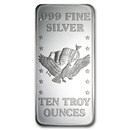U.S. Assay Office Silver Bars
The U.S. Assay Office historically has been a part of the United States federal government's Department of the Treasury. It was primarily responsible for testing and certifying precious metals such as gold and silver to ensure that they met the established standards of purity and quality.
Throughout the history of the United States, multiple Assay Offices have been in operation, many of which were established during the gold rush era in the mid-19th century. Some of these offices were even authorized to convert miners' raw gold into coins or bars, which could then be used for commerce.
About U.S Assay Office Bars
U.S. Assay Office silver bars were issued by the United States government. These silver bars were originally intended for use in international commerce during the mid-to-late 20th century. They are composed of .999 fine silver and come in assorted sizes, most commonly 1,000 and 10 ounces.
These bars are unique because they were minted by the U.S. government, specifically by the U.S. Assay Office, which was under the authority of the United States Treasury Department. The Office used to melt bags of silver coins and then cast them into these bars. They feature the stamp of the U.S. Assay Office and often indicate the purity and weight of the silver bar.
It is worth noting that these silver bars were discontinued when the United States stopped using silver in its coinage. They are no longer minted, but they are still traded and collected in the secondary market. Their value depends not only on the current market price of silver but also on their rarity, condition, and collectible value.
In the late 1960s, the Defense Logistics Agency had over 165 million ounces of silver in its stockpile. The government dumped the silver into the open market in 1980 and 1981 to drive down silver prices after the Hunt brothers tried to corner the market.
U.S Assay Office Bar Details
These silver bars were created using .999 fine silver. The obverse displays "Formerly Stored at U.S. Assay Office in San Francisco" (or New York). Each bar indicates the weight and purity. The reverse is blank. These bars were created for commerce, not for aesthetics. However, they are often priced higher than bars of the same weight due to their historical value.
Since these bars are not “new,” they may show visible imperfections.
For investors interested in the U.S. Assay Office's popular 10 oz silver bar size, you may want to consider the APMEX brand 10 oz silver bar as well. This offers a lower premium since these bars don't have the same rarity and historic value, allowing you to invest in precious metals for less money. Those opting for larger sizes may instead want to explore our full selection of 100 oz silver bars.
Or, for investors seeking the highest quality and brand recognition, Engelhard silver bullion bars make an excellent choice. This Mint has existed since 1902 and is a well-known name in the precious metals industry, making it easier to sell when the time is right.








